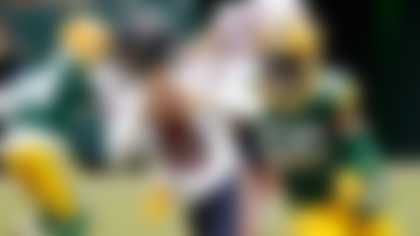In a series leading up to the 2015 NFL Draft, NFL Media historian Elliot Harrison will rank the five best rookie seasons from the Super Bowl era at each major position group. Previously, Elliot examined wide receivers and defensive linemen; today, he eyes quarterbacks who dazzled as newbies.
TOUGHEST OMISSIONS:Andrew Luck, Indianapolis Colts, 2012 (54.1 percent completion rate, 4,374 yards, 23 touchdown passes, 18 interceptions); and Matt Ryan, Atlanta Falcons, 2008 (61.1 percent completion rate, 3,440 yards, 16 touchdown passes, 11 interceptions). (Of course, I'm willing to hear all arguments on the matter @HarrisonNFL.)
5) Greg Cook, Cincinnati Bengals, 1969
Regular-season stats: 53.8 percent completion rate, 1,854 yards, 15 touchdown passes, 11 interceptions, 11 games played (11 starts).
It would be so easy to put Andrew Luck, Matt Ryan or Cam Newton here, but to do that would be to ignore the evolution of the game. In 1969, Cook displayed the natural ability of Luck with the somewhat effortless look of Ryan -- and frankly, as a rookie, Cook was better than both. Future Hall of Fame coach Bill Walsh, who was an assistant in Cincinnati at the time, felt Cook had the potential to be better than any quarterback who had ever laced 'em up. Even some of Cook's 45-year-old numbers bear this out. Cook averaged a regal 9.4 yards per throw; that would have led the league in 2014. His passer rating (88.3) was higher than those of Luck (76.5), Ryan (87.7) or Joe Flacco (80.3) in their respective debut seasons. Sadly, Cook played most of his initial campaign with a torn rotator cuff. Grunting it out like that would ultimately cost the natural his career. After missing the 1970, '71 and '72 seasons, he had a brief return in 1973 -- but there would be no Roy Hobbs-esque finish to his tenure.
4) Robert Griffin III, Washington Redskins, 2012
Regular-season stats: 65.6 percent completion rate, 3,200 passing yards, 20 passing touchdowns, five interceptions, 815 rushing yards, seven rushing touchdowns, 15 games played (15 starts).
I will admit that, in light of his precipitous career decline since, along with the continued excellence of his contemporaries, I almost forgot about the brilliance of RGIII's rookie campaign. In addition to posting a passer rating of 102.4 and leading the league with a sterling 6.8 yards-per-carry mark, the former Baylor standout put Washington on his back and led his team to the playoffs, ultimately taking home the Offensive Rookie of the Year award. Team success is so important when gauging a quarterback; Cam Newton had a wonderful rookie year in 2011, especially statistically (and especially if you had him in fantasy), but that didn't always translate to wins. Luck, meanwhile, did take his squad to the promised land as a rookie, but he also turned the ball over far more often than Griffin (who had seven turnovers to Luck's 23). Unfortunately, an injury sustained late in the season against the Ravens ruined RGIII's effectiveness in the playoffs. Still, no matter what people think of him now, RGIII's debut season was undeniably fantastic.
3) Russell Wilson, Seattle Seahawks, 2012
Regular-season stats: 64.1 percent completion rate, 3,118 passing yards, 26 passing touchdowns, 10 interceptions, 489 rushing yards, four rushing touchdowns, 16 games played (16 starts).
While Luck and RGIII were dominating the headlines back in 2012, Wilson was simply getting better week by week. In the beginning, he avoided making the plays that hurt Seattle; slowly but surely, he started producing the plays that won games. The contest that immediately comes to mind: a Week 13 showdown with the Bears at Soldier Field, during which Wilson led the Seahawks on a pair of 12-play scoring drives -- the first traveling 97 yards and the second 80 -- to tie the game in regulation, then won it in overtime with a 13-yard touchdown strike to Sidney Rice. The clutch performance jump-started a six-game win streak that carried Seattle to the second round of the playoffs. Wilson -- who seemingly never made the big mistake -- was conservatively effective in the passing game while adding serious punch to the running game on read options. He was both efficient and impactful. What else do you want from a rookie quarterback?
2) Ben Roethlisberger, Pittsburgh Steelers, 2004
Regular-season stats: 66.4 percent completion rate, 2,621 yards, 17 touchdown passes, 11 interceptions, 14 games played (13 starts).
If not for a Pittsburgh native, Roethlisberger's rookie campaign would rate as the best ever by a quarterback in the NFL. After relieving Tommy Maddox in Week 2, the kid from Miami of Ohio went 13-0 as a starter. The 11th overall pick in the 2004 draft compiled a noteworthy passer rating of 98.1 -- but more importantly, he showed the football world that a big, strong "pocket" passer could make streetball plays outside of the pocket. Before the Cowboys took on the Steelers that year, legendary head coach Bill Parcells said Roethlisberger was the most impressive rookie quarterback since Dan Marino (the aforementioned Pittsburgh native) -- and that was only in Week 6. Bill Cowher and Co. only asked their rookie phenom to do so much, smartly building a run game around Big Ben that required him to drop back less than 30 times per game, much like the Falcons and Seahawks later did with Ryan and Wilson, respectively. Roethlisberger -- who won the Offensive Rookie of the Year award -- became the first rookie quarterback since the merger to lead his team to the conference championship game.
1) Dan Marino, Miami Dolphins, 1983
Regular-season stats: 58.4 percent completion rate, 2,210 yards, 20 touchdown passes, six interceptions, 11 games played (nine starts).
This shouldn't come as a surprise. Before he turned the football world on its ear in 1984, Marino stunned everyone with his brilliant play as a rookie in 1983. He took over for David Woodley as the starter ahead of a Week 6 loss in Buffalo, although Marino did everything he could to pull that game out, throwing for 322 yards and three touchdowns. He stood tall in the pocket and got rid of the football fast. That made him tough to sack and -- given how quickly he read coverages for such a young passer -- as effective as any veteran in the league. Marino went 7-2 as a starter and made the Pro Bowl as a rookie. Not only did he pass the eye test, he made us all redefine it.
Pre-Super Bowl era: Championship signal-callers
When I think of the top rookie quarterbacks of the pre-Super Bowl era, I think of three guys, each of whom took home a title in their first pro seasons. Hall of Famer Sammy Baugh -- the crown jewel of the 1937 rookie class -- was the NFL's first prolific passer; he was among the top quarterbacks in the NFL in his first year, which he capped off with 335 yards and three touchdowns in the Washington Redskins' 28-21 win over the Bears in the NFL Championship Game. Eight years later, Baugh and Co. were beaten in the title contest by rookie Bob Waterfield and the Cleveland Rams. Waterfield, who had the leadership presence of a veteran, wound up entering the Hall in the Class of 1965 -- the same class as fellow former Cleveland signal-caller Otto Graham. Graham posted a passer rating of 112.1 -- an insanely high figure in those days -- while leading the Browns to an AAFC title in his rookie year of 1946. The Browns were among the three AAFC teams to be assimilated by the NFL for the 1950 season -- joining the Baltimore Colts and San Francisco 49ers -- largely because of the immense success of Graham and his teammates.
Follow Elliot Harrison on Twitter @HarrisonNFL.












